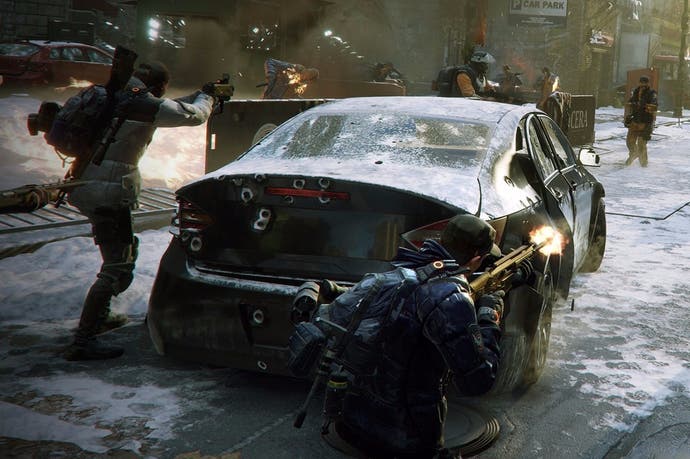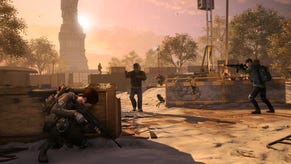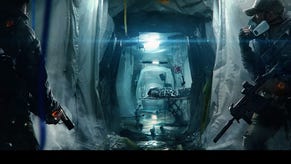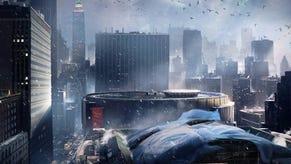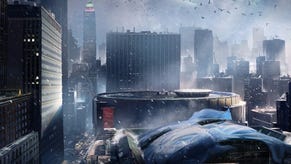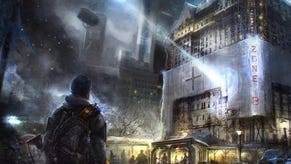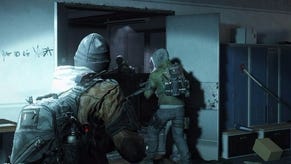What you actually do in The Division
Two hours with the beta for Ubisoft's ambitious open world shooter.
So, what is it you do in The Division? Put in the simplest possible terms, you pad around its gloriously authentic, seamless and recently abandoned New York and you shoot things while working to push the numbers up; watch those digits that float out of the enemy's head shoot skywards, keep your fingers crossed that at the end of it all there'll be a nice new gun that can make even bigger numbers possible and, hey, why not hold out for a nice new hat as well? It's not that hard to get a handle on it after all. You might even have played something just like it not too long ago.
Back in 2013, though, it was easy to be slightly baffled by The Division. A grounded open world with MMO tendencies and chewy Tom Clancy trappings, its combination of cover-based shooting and strong RPG elements got a little lost in the showy confines of an E3 reveal. All most people held on to were those car doors, gently pushed shut in noisy shoot-outs as the player cowered in cover behind bulky, anonymous sedans.
You can still shut those doors, of course. The viral outbreak that's left those city streets eerily empty seems to have sent the inhabitants of Manhattan off in a rush, doors slightly ajar and leaving a nightmare far worse than the collapse of civilisation for anyone with a slightly compulsive personality. After all these years spent following its development, my first five minutes playing The Division were spent prodding all the car doors on a once busy street shut. My co-op partner, meanwhile, puts some of that delicious destruction to the test, shooting out windows and fenders and tires that deflate with a satisfying hiss. The polite UI designer from The Division developer Ubisoft Massive who's supervising us patiently watches on. He understands what needs to be done first.
Then it's on to what The Division's actually about, a pleasantly familiar loop of looting and levelling that's best played with friends in tow. There's certainly more than a slight tang of Destiny in The Division's alchemy of head shots and hit points, and the success of Bungie's shooter has probably helped sell the central idea behind The Division more efficiently than any of Ubisoft's own marketing efforts.
"It's certainly shown that it was a good idea!" says Magnus Jansen, creative director on The Division, whose long, slightly scruffy grey hair perhaps speaks to the nine long years since Massive last released its own game. "To merge shooting with strong RPG elements - I was never worried, but some people who gave it a short amount of thought might think how could you possibly combine these two things? Me having agency, and for the shooting to matter, and an RPG where the numbers dictate the outcome of the combat. Clearly those two things can happily co-exist. That's something we were always very confident in."
To compare The Division to Destiny makes for an easy enough shorthand, though quite often it's not really a fair match-up for either game. The open world that Ubisoft Massive has crafted, a 1:1 model of Manhattan, is more compelling and more expansive than the many planets of Destiny combined. The atmosphere is exceptional, a harsh and endless winter blowing cold mist onto New York's broad swathe of concrete. It's full of those little details that give Tom Clancy games their own special flavour, with recognisable spaces subverted in the chaos. An early mission sees you storm an analogue of Madison Square Gardens where a field hospital has been set up, seeing you work up from an open firefight on the court and surrounding bleachers up through stairways and into a canteen that's been turned over.

It's a seamless space, too, and while it's hard to get a bead on how big it truly is, the sense of scale as you're dwarfed by the imposing high-rises is impressive. There's some swift magic being played by Ubisoft Massive's server tech that means you're never witness to any explicit matchmaking or loading screens. Our session starts in a shared hub that looks like Central Park before we move out into the world itself, and our fire team of three isn't tethered to each other; we're free to explore the world as we please, and it's easy enough to snap back to partners by simply clicking in on the right stick. Missions are picked up in the open world, often funnelling you into buildings where you thin out mobs of enemies in small arenas before taking on bullet sponge bosses.
There are hubs in-between the 15 districts that make up The Division's open world, with shared social spaces where you can meet up with other players alongside a central Base of Operations, home to The Division's meta that sees you building up operations as you explore further out into the world. It's an interesting inverse of the typical Ubisoft template, where instead of a map being slowly won over this one space reflects your progress, completing missions for the people in charge of the three different wings - Tech, Medical and Security - helping you unlock the sprawling skill tree for your own character.
The Division is much more explicit with its RPG tendencies than Destiny dare be, and the Clancy universe - with all its gadgets - makes for a tech tree that glistens like a Christmas fir. You're able to respec your skills at any point, the two active slots being used to switch between wonderful toys like seeker mines, support stations and explosive RC drones that scuttle towards enemy lines. Move closer to The Division's current level cap of 30 and the combat runs satisfyingly deep and tactical as you and your team take on support and aggro roles, juggling the buffs and debuffs that are tossed into the third person shooting. It's a mesh that can work extremely well.

It takes time to sink its teeth into you, though, and there's no escaping the watery feel of The Division's shooting - a problem that doesn't trouble Destiny and its tactile gunplay. The more grounded fantasy also makes for more mundane loot, and unlocking a new variant of kneepad can't quite capture the imagination in the same way (although Jansen does reassure me that there'll be room for more variety in player appearance in the final build.) The Division makes up for that by placing more zeroes on its weapons attributes, overwhelming you with values that run into the thousands.
Ubisoft Massive's smarter than just throwing bigger numbers around, though, and there are glimpses of a wicked and brilliant imagination in The Division. The Darkzone, a PvP area in the centre of the map that can be near seamlessly accessed by just stepping through a door, offers up a deliciously ambiguous take on multiplayer. There are greater rewards available, and while you patrol its murkier streets you stand the chance of encountering other players. There's a tension in those moments, with players free to clash or collaborate in taking down the higher level enemies that guard these areas. There's no guarantee that your own teammates can be trusted, either: it's perfectly possible for players to turn on each other once they've chanced across the prize, with downed players able to be stripped of a small amount of their own loot.
It's this kind of fresh thinking that marks The Division out as something potentially quite special. Other games may have encroached on the space laid out in that flamboyant reveal, but what's impressive is how faithful Ubisoft Massive has been to its initial vision (its faithfulness to the visuals may be up for debate, though Jansen is happy to defend them - "I'm very happy with where we are," he says. "It's a huge game with many times of day, many parts of New York, and the variety we have, the level of execution and the quality of the graphics I think is amazing.")
The delays that have beset The Division - remember, this was a game once slated for 2014 - may well have worked in its favour, too. With Destiny in something of a lull as Bungie prepares its shooter for a sizeable overhaul later this year, there's a fresh appetite for this connected brand of looting and shooting, and The Division looks like it'll have what it takes to satisfy them, for a short while at least. It's been quite the wait, but The Division's time could well be coming.
If you're looking for a little bit of help with the game, our Division guide is up on the site now.
This article is based on a press trip to Malmo. Ubisoft paid for travel and accommodation.
